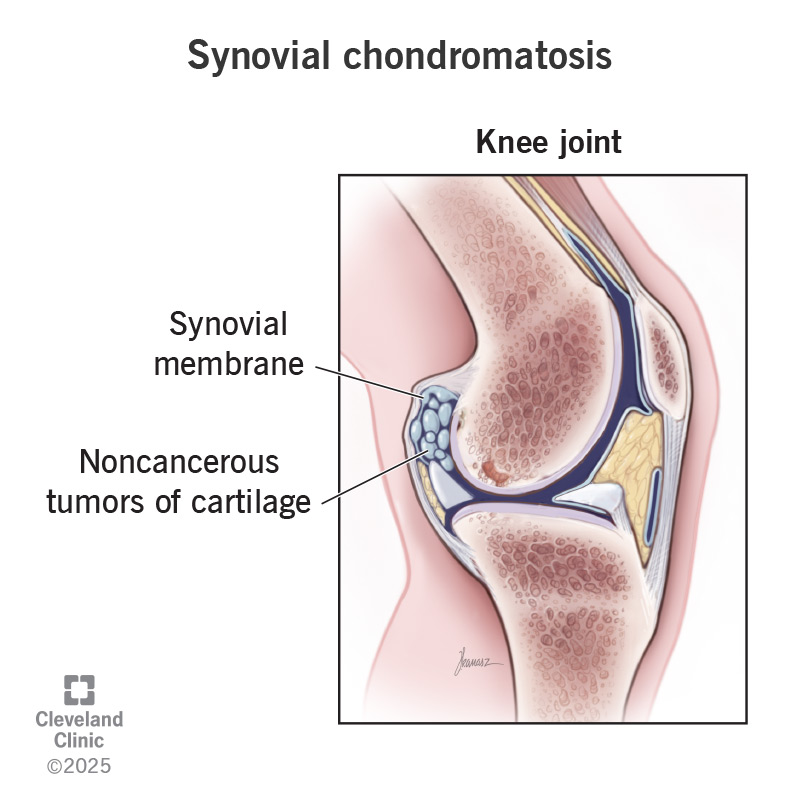Synovial chondromatosis occurs in one of your synovial joints — large joints enclosed within a synovial membrane. Chondromatosis means that cartilage grows abnormally out of the synovial membrane. These growths can irritate and damage your joint. Surgery can remove them.
Advertisement
Cleveland Clinic is a non-profit academic medical center. Advertising on our site helps support our mission. We do not endorse non-Cleveland Clinic products or services. Policy

Synovial chondromatosis is a condition in which small, noncancerous tumors grow in the space around a joint (the joint capsule). The tumors are made of cartilage. (Chondromatosis means abnormal cartilage growth.) They grow out of the thin membrane that lines your joint capsule (the synovial membrane).
Advertisement
Cleveland Clinic is a non-profit academic medical center. Advertising on our site helps support our mission. We do not endorse non-Cleveland Clinic products or services. Policy
Normally, your synovial membrane lubricates your joint and helps reduce friction when it moves. But when there are tumors growing out of it, friction does occur. The tumors can also break off and become loose bodies inside the joint capsule. They can irritate and damage the tissues or get stuck in the joint.
Synovial chondromatosis can be primary or secondary.
Sometimes, the cartilage tumors harden into bone (ossification). Healthcare providers call this synovial osteochondromatosis (osteo- means bone). Other names for this condition include synovial chondrometaplasia and synovial osteochondroma. (Osteochondroma is a noncancerous bone tumor.)
Synovial chondromatosis causes symptoms similar to arthritis. It’s usually in just one joint, but sometimes it’s in the same joint on both sides (like both your knees). Joint pain and swelling are the most common complaints. Most people have pain when they’re at rest that gets worse when they move the joint.
Advertisement
You may also have:
Synovial chondromatosis usually occurs in larger joints that take a lot of daily stress, like your:
Symptoms of synovial chondromatosis can be debilitating — like arthritis. But unlike arthritis, this condition is curable. Surgery can remove the tumors and stop them from damaging your joint. If you have worsening pain in a joint — even one that’s troubled you for a while — check in with your provider.
Most of the time, synovial chondromatosis occurs in joints that have already taken a lot of wear and tear or damage from a chronic disease. In this case (secondary chondromatosis), the cartilage growing in your synovial membrane almost resembles a type of scarring process, similar to bone spurs on bones.
Some conditions that can set the stage for secondary synovial chondromatosis include:
Primary synovial chondromatosis occurs for unknown reasons. Whereas the secondary type may develop from osteoarthritis, primary synovial chondromatosis can be the cause of osteoarthritis. Loose cartilage and bone pieces in your joint can irritate and wear down the soft tissues in your joint.
Besides preexisting joint disease, your sex is the most important risk factor. Synovial chondromatosis affects males four times more than females.
Synovial chondromatosis can cause permanent damage to your joint. The effect is like an accelerated form of osteoarthritis. The constant friction and inflammation in your joint wear down the cartilage and harden the synovial membrane. If this continues, you might eventually need joint replacement surgery.
Very rarely, a benign cartilage tumor can turn into a cancerous one. This is called chondrosarcoma.
A healthcare provider will examine your affected joint, then order imaging tests. Cartilage tumors in the joint will usually show up on X-rays. Occasionally, it may take a CT scan or MRI to see the smaller ones. Imaging tests may also show inflammation in your joint and evidence of tissue damage.
Treatment for synovial chondromatosis depends on how much the condition affects your joint. If tumors don’t cause too much discomfort or damage, your provider might suggest watching to see if this happens.
You can treat your symptoms at home with:
But if loose tumors are getting stuck in your joint and seriously limiting your range of motion or damaging the cartilage in your joint, your orthopedist may recommend surgically removing them. Surgeons can often do it by minimally invasive surgery methods, like arthroscopy. But you may need open surgery if you have tumors in your hip or the back of your knee.
Advertisement
Additional procedures might include:
Synovial chondromatosis can be damaging, but it’s treatable. Your outlook depends on how soon you get treatment, how much damage your joint has and whether the tumors come back after treatment. Your healthcare provider can tell you more about what to expect based on your unique condition.
It’s easy to take your joints for granted until they start causing you pain — especially the large joints you rely on to get around every day. When these joints stop working properly, you might be tempted to ignore your symptoms and hope they go away, or to despair and think they’ll never be the same again.
Instead, check in with your healthcare provider. Synovial chondromatosis can be very harmful to your joints, but it’s also very treatable. The sooner you have a diagnosis and treatment, the more likely it is your joint will recover without too much permanent damage — and go on to serve you another decade.
Advertisement
From sudden injuries to chronic conditions, Cleveland Clinic’s orthopaedic providers can guide you through testing, treatment and beyond.

Last reviewed on 10/12/2025.
Learn more about the Health Library and our editorial process.